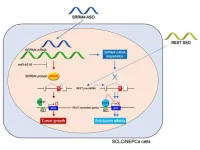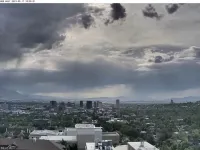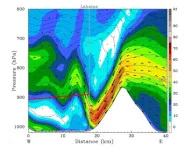(Press-News.org) Ever wondered why you performed worse than expected in that final university exam that you sat in a cavernous gymnasium or massive hall, despite countless hours, days and weeks of study? Now you have a genuine reason – high ceilings.
New research from the University of South Australia and Deakin University has revealed a link between rooms with high ceilings and poorer examination results.
A study published in the Journal of Environmental Psychology, led by architecture and psychology-trained UniSA researcher Dr Isabella Bower in collaboration with educational psychology researcher Associate Professor Jaclyn Broadbent from Deakin University, demonstrates that building design impacts our ability to perform tasks.
Dr Bower and her team analysed data from 15,400 undergraduate students between 2011-2019 across three campuses at an Australian university, comparing students’ exam results with ceiling heights of the room in which they sat the examination.
After considering individual student differences and their prior performance in coursework, they found that students had lower scores than expected when sitting exams in rooms with an elevated ceiling.
The researchers factored in the students’ age, sex, time of year when sitting the examination, and whether they had prior exam experience in the courses investigated.
Dr Bower says it is difficult to identify whether this is due to the scale of the room itself, or factors such as student density or poor insulation, which in turn lead to fluctuating temperatures and air quality – all factors that can affect the brain and body.
“These spaces are often designed for purposes other than examinations, such as gymnasiums, exhibitions, events and performances,” Dr Bower says.
“The key point is that large rooms with high ceilings seem to disadvantage students and we need to understand what brain mechanisms are at play, and whether this affects all students to the same degree.”
The results support experiments that Dr Bower has done using virtual reality (VR), measuring brain activity of participants exposed to different rooms, while controlling for other factors such as temperature, lighting and noise.
Using a technique called electroencephalography (EEG), where electrodes are attached to the scalp to measure brain cell communication, her team altered room sizes, while recording the brain’s response. They also measured heart rate, breathing and perspiration, revealing if someone could unconsciously detect a change to the environment.
In these VR experiments, they found that simply sitting in a bigger room resulted in brain activity associated with concentrating on a difficult task. This led them to question if task performance in large spaces is reduced.
“Based on these results we were curious to apply our lab findings to a real-world dataset and see if being in a large space like a gymnasium while having to concentrate on an important task would result in a poorer performance,” Dr Bower says.
“Examinations have been a key part of our education system for over 1300 years, shaping students' career paths and lives,” says Assoc Prof Jaclyn Broadbent.
In Australia, many universities and schools use large indoor spaces for exams to streamline logistics and costs. It's crucial to recognise the potential impact of the physical environment on student performance and make necessary adjustments to ensure all students have an equal opportunity to succeed," she says.
“These findings will allow us to better design the buildings in which we live and work, so we can perform to the best of our ability.”
A video explaining the research can be found at https://youtu.be/1x54T1scTIA
Dr Bower has recently returned from Zurich, where she was the first Australian to receive a NOMIS and Science Young Explorer Award for her ongoing research into building design on brain functioning and mental health.
Notes for editors
“Elevated ceiling heights reduce the cognitive performance of higher-education students during exams” is published in the Journal of Environmental Psychology. DOI: https://doi.org/10.1016/j.jenvp.2024.102367
The paper is authored by Dr Isabella Bower and Dr Scott Coussens from the University of South Australia, and Associate Professor Jaclyn Broadbent and Professor Peter Enticott from Deakin University.
END
High ceilings linked to poorer exam results for uni students
2024-07-03
ELSE PRESS RELEASES FROM THIS DATE:
Low-dose aspirin could help prevent pregnancy complications caused by flu infections
2024-07-03
A world-first study has found low-dose aspirin may treat flu-induced blood vessel inflammation, creating better blood flow to the placenta during pregnancy.
Animal studies examined whether the treatment for preeclampsia could be applied to flu infections – and the results, according to the research team, were very promising.
Lead researcher and RMIT Post-Doctoral Research Fellow, Dr Stella Liong, said flu infections during pregnancy can resemble preeclampsia, a pregnancy complication that causes inflammation to the aorta and blood vessels.
Low-dose aspirin is commonly taken to prevent preeclampsia, as it stops the body from creating chemicals that cause ...
Splicing it all together in the fight against cancer
2024-07-03
Osaka, Japan – Neuroendocrine tumors, including small cell lung cancer and neuroendocrine prostate cancer, are very aggressive with high chances of spreading. However, many individuals develop resistance to few available treatment options, leading to poor patient outcomes. Researchers are therefore aiming to develop new therapeutic methods that focus on the disease-specific molecular mechanisms of these tumors.
In a recent article published in Molecular Therapy: Nucleic Acids, a team of researchers at Osaka University describe a strategy targeting one such mechanism, called RNA splicing.
RNA splicing is the process ...
World’s first research journal dedicated to psychology and artificial intelligence announced
2024-07-03
Taylor & Francis has announced the launch of the Journal of Psychology and AI, an open access journal that aims to foster dialogue between technologists developing artificial intelligence (AI) systems and psychology researchers exploring human behavior, cognitions, and emotions.
As AI technology becomes increasingly integrated into our lives, the new journal will publish reports on direct human interaction with AI as well as exploring how it is influencing the way we interact with and think about the world.
Other research areas relevant to psychology and AI include using AI for the ...
Zayed to lead new Division of Surgical Sciences
2024-07-03
Mohamed A. Zayed, MD, PhD, a vascular surgeon known for his pioneering research in vascular diseases, has been appointed director of the newly established Division of Surgical Sciences in the Department of Surgery at Washington University School of Medicine in St. Louis. He will assume his new role July 1.
Zayed, a professor of surgery, of radiology, of molecular cell biology, and of biomedical engineering, has more than 25 years of experience leading multifaceted research programs in biotech, medical startups ...
How dust pollution from shrinking Great Salt Lake affects communities disproportionately
2024-07-03
New research from the University of Utah demonstrates how wind-carried dust from the exposed bed of Great Salt Lake is disproportionately affecting disadvantaged communities in the Salt Lake metro area.
The findings suggest restoring the lake to a healthy water level would reduce disparities in harmful dust exposure experienced by different racial/ethnic and socioeconomic groups, along with delivering other ecological and economic benefits.
Exposure to particulate pollution arising from dry portions of the playa is highest among Pacific Islanders and Hispanics and lowest among white people compared to other racial/ethnic ...
Clever clothes! Seams in clothing capture body movement
2024-07-03
Everyday clothing may soon be able to capture and record body movements according to new research published by the Universities of Bristol and Bath.
Harmless low voltages are passed through conductive threads which are stitched into garment seams to create electrical circuits. Their resistance changes with the movement of the wearer's body. The work opens up new possibilities to make digital clothing which senses and captures movements much more accurately than is possible using current phones and smart watches.
The paper, presented at the Designing Interactive Systems (DIS) conference in Copenhagen ...
AMS science preview: Maui wildfire, Salt Lake drying, traffic and weather
2024-07-02
The American Meteorological Society continuously publishes research on climate, weather, and water in its 12 journals. Many of these articles are available for early online access–they are peer-reviewed, but not yet in their final published form.
Below is a selection of articles published early online recently. Some articles are open-access; to view others, members of the media can contact kpflaumer@ametsoc.org for press login credentials.
JOURNAL ARTICLES
Understanding Observed Precipitation Change and the New Climate Normal from the Perspective of Daily Weather Types in the Southeast U.S.
Journal of ...
Research spotlight: Identifying genes to prolong an anti-tumor immune response
2024-07-02
How would you summarize your study for a lay audience?
We set out to identify genes that are commonly expressed in CD8+ T cells, killer immune cells that can drive anti-tumor immunity, across many types of human cancers. Our goal was to uncover new therapeutic targets, which could inform novel treatment strategies that could benefit many patients. To do this, we developed a novel mathematical method that can be applied to data from many types of cancers.
What knowledge gaps does your study help to fill?
We know the presence fof CD8+ T cells is essential for ...
SRI is developing a new malaria treatment that aims to protect from the disease
2024-07-02
SRI today announced that researchers are developing a new treatment that aims to provide a better option to fight malaria, particularly for people in low-income and rural regions. Researchers in SRI’s Pharmaceutical Sciences Lab are working on an affordable, shelf-stable anti-malarial drug formulation that could provide months of protection against the mosquito-borne disease with just a single injection, which means that individuals would no longer have to worry about missing a dose. Additionally, it has a low propensity for resistance and can be ...
UV radiation damage leads to ribosome roadblocks, causing early skin cell death
2024-07-02
In a recent study, researchers at Johns Hopkins Medicine suggest the cell’s messenger RNA (mRNA) — the major translator and regulator of genetic material — along with a critical protein called ZAK, spur the cell’s initial response to UV radiation damage and play a critical role in whether the cell lives or dies.
While UV radiation has long been known to damage DNA, it also damages mRNA, and the latest findings, published June 5 in Cell, indicate that mRNAs act as first responders in telling the cells how to manage the stress.
“RNA is a canary in the coal mine. It’s telling the cell, ‘We’ve got major damage here and ...





